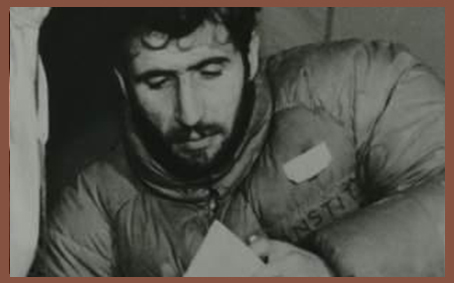One of the most unusual cave stays ever recorded began on February 13, 1972, when 33-year-old French geologist Michel Siffre climbed into Midnight Cave near Del Rio, Texas. He didn't, come out again until September 5th. For six months, Siffre was isolated in a large cave chamber 440-feet from the entrance.  His furnishings were sparse: a tent erected on a wooden platform was equipped with a bed, table and chair, and various machines for science experiments. The chamber was also stocked with frozen food and almost 800 gallons of water.
His furnishings were sparse: a tent erected on a wooden platform was equipped with a bed, table and chair, and various machines for science experiments. The chamber was also stocked with frozen food and almost 800 gallons of water.
Perhaps more important is what the chamber did not contain: there were no calendars or clocks or anything that would help him establish the day or time. By placing a person in an isolated environment, without normal day and night cycles and without clocks or timing devices of any kind, scientists hoped to determine what natural body rhythms Siffre might develop. This would help them predict the effects of long-term missions on crews of nuclear submarines and spaceships.
Siffre was no stranger to such experiments. In 1962 he had stayed 63 days in a French alpine cave, the longest time anyone had lived isolated underground. That experiment and others seemed to show that some people begin to develop a 48-hour day, when all sense of time is removed.
In Midnight Cave, each one of Siffre's "days"involved a set morning routine. As soon as he awakened, he reached for the nearby telephone to let above-ground researchers know that he was awake. Immediately, lights controlled by the researchers were turned on, and Siffre began a four-hour regimen of experiments. First he took his blood pressure, then a series of mental, memory, and physical tests. He rode a stationary bicycle for three miles and used a pellet gun for five rounds of target practice. When he shaved, he collected his whiskers for experiments at the University of Minnesota.
During his free time, he swept the guano-filled cave, trying not to breath the dust which could cause him to develop a lung disease. He had planned to listen to music and read to fill the lonely hours. Unfortunately, the damp cave environment caused his stereo to malfunction and ever-present mildew to attack his books.
By the end of the first month, he was living a 26-hour cycle, though he didn't know it at the time. He simply stayed awake as long as he wanted and called it a "night" when he felt tired. He let the researchers know when he was ready to sleep, and the lights were turned off. He kept a diary that tracked his own days and nights, but his calculations were not accurate. For example, his Day 63 was really Day 77, aboveground.
His diary also recorded his thoughts and feelings. At first excited, Siffre eventually became depressed by the total isolation. He began to dislike the telephone, his one method of communication with the outside world, because it represented a freedom that he could not have.
His reaction to cave mice demonstrated quite clearly how he changed in the course of the experiment. During the first few weeks underground, he could hear mice at "night" as he prepared to sleep Their noises annoyed him, and he set many traps for them. He caught eight, wiping out the entire mouse colony.
Five months into the experiment, however, he was starved for companionship. On Day 162, when he heard a noise and realized that another mouse had come to visit, he was ecstatic. "Another living creature exists in Midnight Cave!" he wrote in his journal. "If I trap this rodent, I will have a companion."
For eight days, Siffre tried to catch and tame the mouse. He used a pea, then some jam, placed beneath a propped-up casserole dish. The mouse, named Mus by Siffre, was timid and avoided capture. Finally, Mus was caught, but with an unexpected result.
Siffre wrote:
My patience prevails. After much hesitation, Mus edges up to the jam. I admire his little shining eyes, his sleek coat. I slam down the dish. He is captured! At last I will have a companion in my solitude. My heart pounds with excitement. For the first time since entering the cave, I feel a surge of joy. Carefully I inch up the casserole. I hear small squeaks of distress. Mus lies on his side. The edge of the descending dish apparently caught him on the head. I stare at him with swelling grief. The whispers die away. He is still. Desolation overwhelms me.
Nine real days later, on August 10th, the isolation part of the experiment ended. Although Siffre had to remain underground for almost four more weeks for further tests, scientists could now visit him. Obviously, he was overjoyed.
When he finally emerged from the cave on September 5th, on Day 205, he found himself a changed man. His eyesight had worsened, he had developed a chronic squint, and some psychological troubles bothered him. He concluded that, even though he was able to develop a 28-hour day without the constraints of time, future space travelers would have serious trouble adapting to long-distance travel in confined areas. Of course, they would not have the mildew or bat guano that plagued Siffre. And, he hoped, they might have the benefit of some companionship.

Copyright © James M. Deem. Taken from an unpublished manuscript by James M Deem. All rights reserved.

Other Cave Stories by James M Deem
Floyd Collins: Trapped in Sand Cave! The Cave of Glowing Skulls
The Cave of Glowing Skulls
The Hidden Treasure of Lascaux Six Months Alone in Midnight Cave
Six Months Alone in Midnight Cave